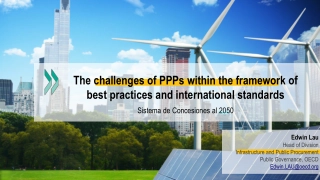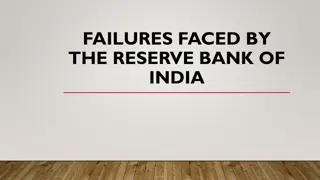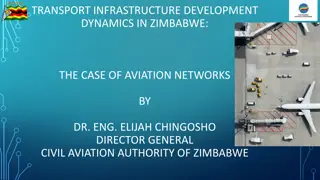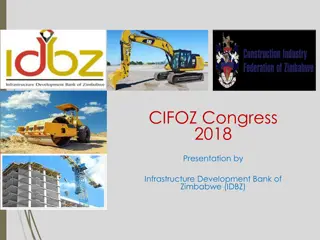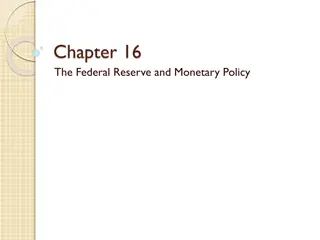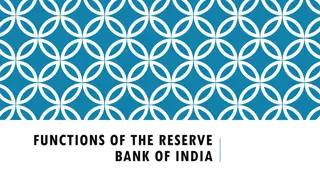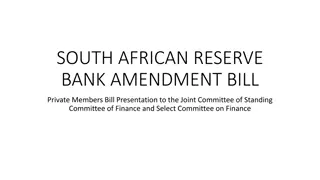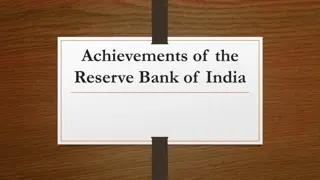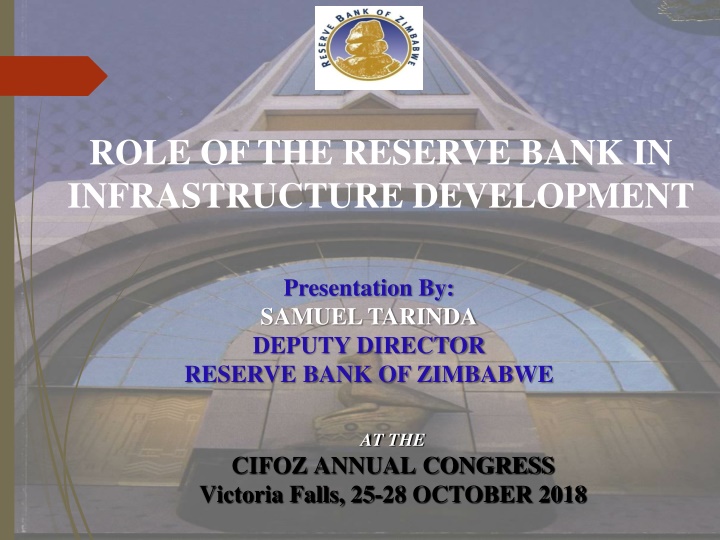
Role of Reserve Bank in Infrastructure Development in Zimbabwe
Infrastructure is crucial for economic growth and development goals. This presentation by Samuel Tarinda, Deputy Director of Reserve Bank of Zimbabwe, highlights the impact of infrastructure on the country's competitiveness, financing gaps, and policy thrust. It discusses the state of infrastructure in Zimbabwe, challenges faced, and opportunities for development. Regional competitiveness in infrastructure is also analyzed, shedding light on Zimbabwe's standing compared to other SADC countries.
Download Presentation

Please find below an Image/Link to download the presentation.
The content on the website is provided AS IS for your information and personal use only. It may not be sold, licensed, or shared on other websites without obtaining consent from the author. If you encounter any issues during the download, it is possible that the publisher has removed the file from their server.
You are allowed to download the files provided on this website for personal or commercial use, subject to the condition that they are used lawfully. All files are the property of their respective owners.
The content on the website is provided AS IS for your information and personal use only. It may not be sold, licensed, or shared on other websites without obtaining consent from the author.
E N D
Presentation Transcript
ROLE OF THE RESERVE BANK IN INFRASTRUCTURE DEVELOPMENT Presentation By: SAMUEL TARINDA DEPUTY DIRECTOR RESERVE BANK OF ZIMBABWE AT THE CIFOZ ANNUAL CONGRESS Victoria Falls, 25-28 OCTOBER 2018
PRESENTATION OUTLINE INTRODUCTION ZIMBABWE S INFRASTRUCTURE & FINANCING GAP POLICY THRUST TOWARDS INFRASTRUCTURE DEVELOPMENT FINANCING OF INFRASTRUCTURE CONSTRUCTION OPPORTUNITIES IN INFRASTRUCTURE DEVELOPMENT CONCLUSION
INTRODUCTION Infrastructure is critical to delivering growth, reducing poverty and addressing broader development goals; It includes public investment in physical assets and social services or social overhead capital as Development Economists put it ,. It increases economic growth directly through increased construction activities and employment; Indirectly increases business opportunities by making investments more productive, reducing transactions costs, promoting communications, and creating economic and social interactions.
INTRODUCTION It can also be treated as a factor of production or simply be regarded as a direct input into the production process; Infrastructure can also act as a stimulus to aggregate demand. In this regard, governments across the globe often use large-scale infrastructure projects as stimulus policies during recessions or in order to achieve particular growth targets: An example, closer home, is South Africa s Expanded Public Works Programme (EPWP) which has been instrumental in raising aggregate demand in South Africa.
STATE OF INFRASTRUCTURE IN ZIMBABWE Zimbabwe used to have one of the most developed infrastructure in terms of coverage and quality in sub- Saharan Africa. Over the last decade, however, limited investment in maintenance and expansion has led to a deterioration in the country s infrastructure, consequences on service delivery and industrial competitiveness. The challenge has been compounded by limited access to long term external credit, particularly foreign direct investment (FDI). Although the country ranks poorly in global in infrastructure competitiveness, ithowever, compares favourably with some peers in the SADC region. with adverse
Regional Competitiveness (Infrastructure) Index 2017 2018 At 116 out of 137 countries, Zimbabwe ranks poorly in terms of Infrastructure Competitiveness. 160 140 120 Though standing right at the middle of competitiveness rankings in SADC, the country s infrastructure significantly lags behind Malawi, Madagascar and Mozambique. 100 80 60 40 20 0
Global Competitiveness Index 20172018: Infrastructure Ranking 2015-16 2017-18 Though slightly improved since 2015, Zimbabwe s ratings remain generally poor across all aspects of key infrastructure indicators. Description Rank/140 Rank/137 Quality of overall infrastructure 121 115 Quality of roads 98 116 Quality of railroad infrastructure 83 86 Quality of port infrastructure 102 108 Quality of air transport infrastructure 115 104 Available airline seat km/week, millions 120 120 Quality of electricity supply 132 112 Mobile telephone subscriptions/100 pop 115 115 Fixed-telephone lines/100 pop 114 109
STATE OF INFRASTRUCTURE IN ZIMBABWE (2) In 2011, the African Development Bank estimated that Zimbabwe requires about $14.2 billion for infrastructure rehabilitation and development. Government has since updated the country s infrastructure funding requirements to close to US$30 billion. Government capital expenditure in 2017 was US$1.34 billion, representing 22% of total expenditures, but minimal amounts went into infrastructure.
Structure of Government Expenditure in 2017 Capital 22% Recurrent 78%
POLICY THRUST TOWARDS INFRASTRUCTURE DEVELOPMENT Successive Infrastructure development, given its centrality in the economic and development matrix, as a key enabler. Government economic blueprints have prioritized The Transitional Stabilisation Programme (TSP) recognizes the critical role played by a functional public infrastructure, in unlocking economic growth potential, increase competiveness and productivity, and enhancing service delivery. The Programme prioritises quick-win projects in energy, water and sanitation, ICT, housing and transport, with focus on expediting completion of ongoing infrastructure projects. The TSP targets increasing the Budget on capital expenditures to over 25 percent, with more allocations towards infrastructure development.
TYPE OF INFRASTRUCTURE PROJECT DESCRIPTION ESTIMATED COST (US$ MILLION) Electricity Thermal power: Hwange expansion, Byo, Gwayi, Gokwe North Hydro: Batoka hydro, 12,188 Solar: Gwayi, Mutoko Transmission and Distribution network Roads Dualization Harare ring (80km) Harare-Masvingo-Beitbridge (575km) Harare-Chirundu (352km) Harare-Nyamapanda (238km) Bulawayo-Beitbridge (322km) Bulawayo- Victoria Falls (439km) 2,242 Rail Network Rehabilitation Track repair, communication, locomotives, coaches 2,131 Airports Rehabilitation and Development Robert Mugabe International Airport, Weather observation, Runway 180 Joshua M. Nkomo Airport New control tower Traffic control, Communication, Navigational aids Water and Sanitation Harare and Bulawayo Water works; rehab and upgrade Sewerage; rehab and upgrade 2,349
FINANCING OF INFRASTRUCTURE The Reserve Bank superintends over financial institutions, which in turn play a catalytic role in infrastructure financing and development. Building Societies Infrastructure Development Bank of Zimbabwe (IBDZ) play a more direct role in infrastructure financing. Commercial and Merchant Banks provide supplementary financing for infrastructure, through dedicated units and products. The Banking & Financial Sector designs and financing products and services to the infrastructure sector. and the innovative offers
Trends in Building Societies Mortgage Financing (US$) Most Housing Projects are financed through bank mortgages, as well as other external facilities. 600.00 Millions 500.00 400.00 Banks provide working capital and other short- term financing, mainly to the construction sector, and other value chain players in infrastructure development. 300.00 Takeover of NPLs by ZAMCO 200.00 100.00 - Nov-09 Nov-14 Sep-10 Feb-11 Sep-15 Feb-16 Oct-17 Oct-12 May-12 May-17 Aug-13 Aug-18 Jun-09 Jul-16 Jul-11 Jun-14 Apr-15 Apr-10 Dec-11 Dec-16 Jan-09 Jan-14 Mar-13 Mar-18
Infrastructure Value Chain Financing Banks and other Financial Institutions are involved in financing at each stage of the Value Chain.
Infrastructure Financing Instruments & Options Infrastructure Bonds Use of infrastructure bonds have also become common to finance infrastructure in developing countries. The infrastructure bonds can be raised from the domestic markets or international capital markets. Government will, under the TSP, revive the issuance of bonds through the development of a secondary bond market, beginning 2019. The funds unlocked through these bonds provide opportunities for building contractors to participate in the targeted infrastructure projects.
Infrastructure Financing Instruments & Options Sovereign Bonds Other African Governments have resorted to international markets to finance infrastructure projects. Part of the bond proceeds are used to clear arrears with bilateral and multilateral creditors, which helps to unlock new and additional funding for long term infrastructure projects. According to the UK-based Overseas Development Institute (ODI), Sub-Saharan Africa sovereign bonds increased from $6 billion in 2012 to a record $11 billion in 2014. First to test the waters was Seychelles, which in 2006 was the first in sub-Saharan Africa, outside South Africa, to issue sovereign bonds. It was quickly followed by Ghana ($750 million in 2007); and later joined by Ethiopia ($1.5 billion in 2014); Kenya ($2 billion in 2014); and others (C te d Ivoire, Nigeria, Rwanda, Namibia and Zambia).
Infrastructure Financing Instruments & Options Public Private Partnerships (PPPs) The Joint Venture Act Zimbabwe (Chapter 22 of 2016) is now operational, and a Joint Venture Unit was established within the Ministry of Finance. The Act provides a framework for guiding PPPs in many spheres of economic and development ventures. Successful PPPs in some countries have been underpinned by supplementary documents, resource materials and manuals outlining the institutional arrangements and capacity building of public officials involved in implementing PPP projects. Infrastructure investment, rehabilitation, maintenance and development are fertile grounds for implementing PPPs and joint ventures.
Infrastructure Financing: PPPs PARTNERSHIP OF: Resources Risks Returns Rewards
Infrastructure Financing Instruments & Options Tapping into Diaspora Government is exploring ways to tap into diaspora remittances to fund and develop infrastructure. Current efforts by Reserve Bank of Zimbabwe to incentivise diaspora inflows will ensure that the remittances are received through formal channels making it easier to tap them into infrastructure projects. This will enhance and expand sources of financing infrastructure in the country, and provides additional platform for participation of building contractors.
Infrastructure Financing Instruments & Options User Fees Infrastructure Financing Model The transport infrastructure can also be financed through user fees, where the greater proportion of costs can be recouped from the users e.g. the Harare- Beitbridge Road; Beitbridge-Chirundu; etc. are partly self-financed through toll fees. Other types of financing take the forms of Build, Operate and Transfer (BOT, BOOT). These projects provide significant subcontracting opportunities to local construction industry players.
OPPORTUNITIES FOR THE CONSTRUCTION INDUSTRY The current huge infrastructure gap in the economy presents significant upside opportunities for building contractors in the country. There are significant opportunities for building contractors to participate in the rehabilitation, maintenance and expansion of infrastructure in the area of roads, railways, air, water, ICT and energy (hydro, thermal, solar, wind, etc). Regional Infrastructure Initiatives e.g. by AfDB and DBSA - launched the Africa50 Infrastructure Investment Platform designed to significantly narrow the infrastructure finance gap in Africa. This is an avenue for foreign exchange generation. Africa50 focuses on the high-impact national and regional projects in the energy, transport, ICT and water.
Opportunities from International Re- Engagement Successful engagement with the IFIs will undoubtedly increase the participation of development and cooperating partners into infrastructure development in the country. The anticipated new funding from multilateral towards development opportunities contractors to unfolding infrastructure projects. institutions infrastructure will for building take part provide in
CONCLUSION The provision of adequate infrastructure and related services is indispensable for economic development. The adequacy of infrastructure helps to determine a country s success or failure in diversifying production, coping with population growth, reducing poverty and improving environmental conditions. The huge infrastructure gaps in the country, while providing immense opportunities for the private sector, however, show that the task of developing infrastructure can no longer be left to the Government alone. Governmentinvolvement critical public nature of most infrastructure.

